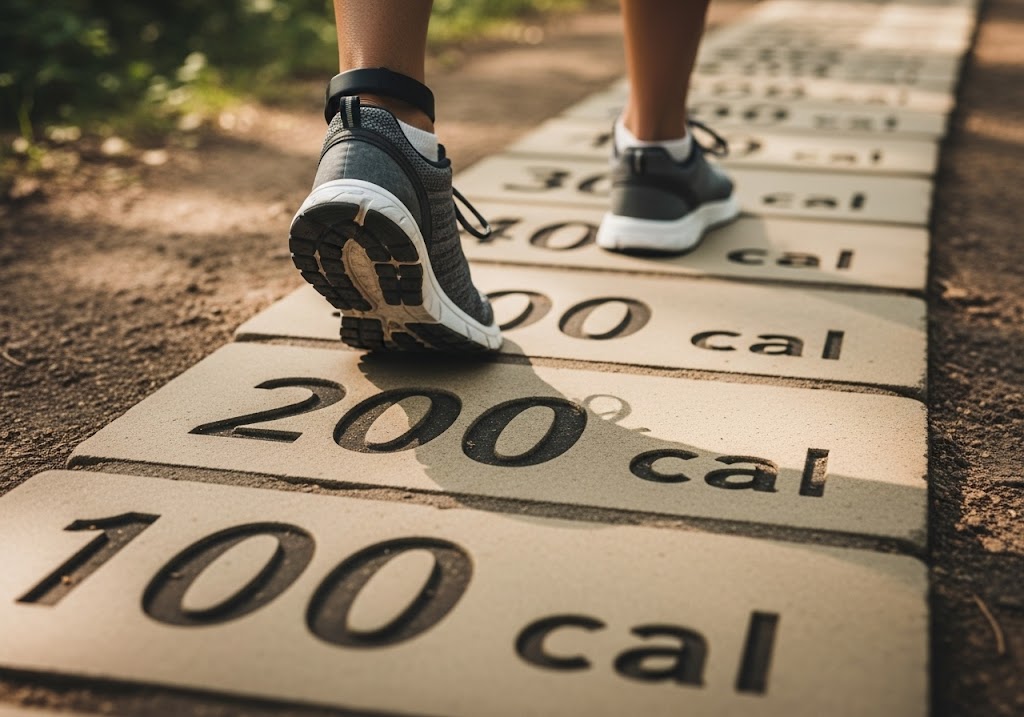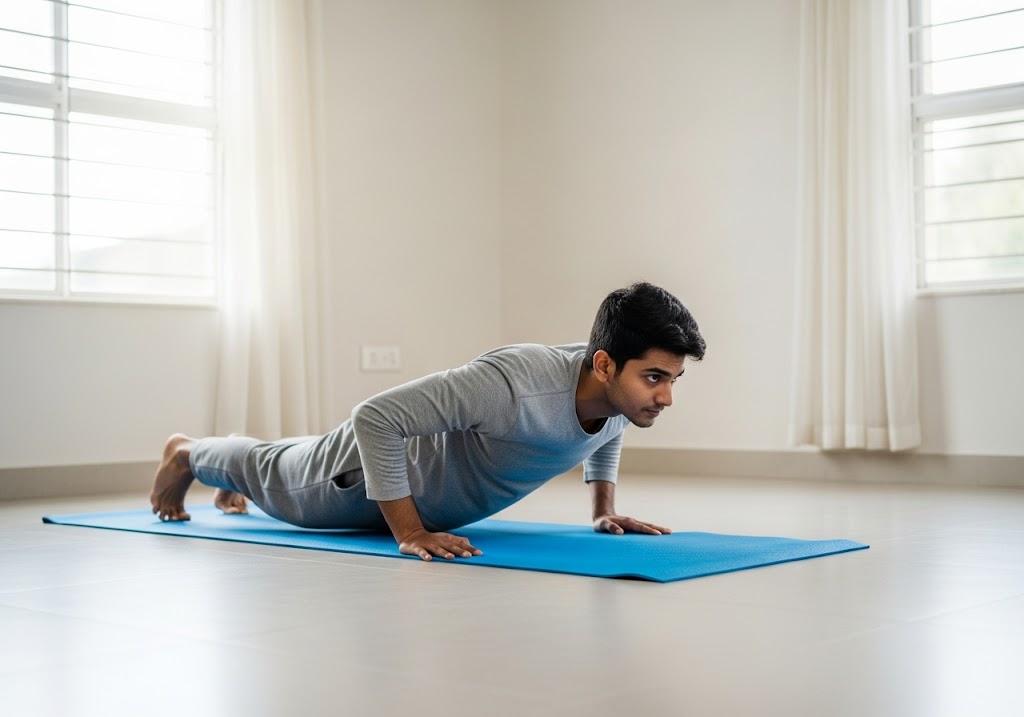How many steps to burn 500 calories? Most people need 8,000-15,000 steps to burn 500 calories, with heavier individuals (90kg+) requiring fewer steps and lighter individuals (50-60kg) needing more steps.
Want to know exactly how many steps to burn 500 calories for effective weight loss? The answer typically ranges from 10,000 to 15,000 steps depending on your body weight, walking speed, and terrain. Understanding how many steps needed to burn 500 calories helps create realistic daily walking goals for sustainable fat loss and improved health through consistent physical activity.
Table of Contents
Understanding Calorie Burn Through Walking
Walking represents one of the most accessible forms of exercise for burning calories and improving overall health. The relationship between steps and calorie expenditure depends on multiple factors that influence energy consumption during physical activity.
Your body burns calories through walking by engaging large muscle groups in your legs, core, and arms while maintaining balance and forward momentum. The metabolic demand increases with walking speed, incline, and duration, making it an effective tool for weight management and cardiovascular health improvement.
For comprehensive fitness routines that complement walking, exploring full body calisthenics workout provides excellent strength training options to enhance your overall fitness results.

How Many Steps to Burn 500 Calories by Body Weight?
Understanding how many steps to burn 500 calories requires considering your body weight as the primary factor influencing calorie expenditure. Heavier individuals burn more calories per step due to increased energy requirements for movement.
| Body Weight | Steps for 500 Calories | Distance (km) | Time Required |
|---|---|---|---|
| 50 kg | 12,500-15,000 | 8-10 | 100-120 min |
| 60 kg | 11,000-13,000 | 7-9 | 90-110 min |
| 70 kg | 10,000-12,000 | 6.5-8 | 80-100 min |
| 80 kg | 9,000-11,000 | 6-7.5 | 70-90 min |
| 90 kg | 8,000-10,000 | 5.5-7 | 65-85 min |
| 100 kg | 7,500-9,500 | 5-6.5 | 60-80 min |
Dive into the facts with does jumping jacks reduce belly fat to find out how they fit into your fat-loss strategy.
How Many Steps and Kilometers to Burn 500 Calories?
Understanding the relationship between walking distance, step count, and calorie burn helps set realistic fitness goals and plan effective walking routines. Individual calorie expenditure varies based on body weight, walking speed, terrain, and personal metabolism. These calculations provide general guidance for incorporating walking into weight management and fitness programs.
Steps and Distance to Burn 500 Calories
| Body Weight | Steps Required | Distance (km) | Distance (miles) | Estimated Time |
|---|---|---|---|---|
| 50-60kg | 12,500-15,000 | 6.0-7.5 km | 3.7-4.7 miles | 60-90 minutes |
| 60-70kg | 10,000-12,500 | 5.0-6.0 km | 3.1-3.7 miles | 50-75 minutes |
| 70-80kg | 8,500-10,000 | 4.0-5.0 km | 2.5-3.1 miles | 40-60 minutes |
| 80-90kg | 7,500-8,500 | 3.5-4.0 km | 2.2-2.5 miles | 35-50 minutes |
| 90kg+ | 6,500-7,500 | 3.0-3.5 km | 1.9-2.2 miles | 30-45 minutes |
Master strict form with how to do hanging leg raises without swinging.
Calorie Burn by Walking Distance
Walking different distances provides scalable calorie burn options that accommodate various fitness levels, time constraints, and exercise goals. Understanding calorie expenditure per kilometer helps plan effective walking routines while maintaining realistic expectations. These estimates support sustainable exercise habits and long-term fitness success through accessible walking programs.
Calorie Burn by Distance Table
| Distance | 60kg Person | 70kg Person | 80kg Person | 90kg Person | Estimated Time | Steps Required |
|---|---|---|---|---|---|---|
| 1 km | 40-50 calories | 45-55 calories | 50-65 calories | 60-75 calories | 10-12 minutes | 1,200-1,500 |
| 5 km | 200-250 calories | 225-275 calories | 250-325 calories | 300-375 calories | 50-60 minutes | 6,000-7,500 |
| 10 km | 400-500 calories | 450-550 calories | 500-650 calories | 600-750 calories | 100-120 minutes | 12,000-15,000 |
| 20 km | 800-1000 calories | 900-1100 calories | 1000-1300 calories | 1200-1500 calories | 200-240 minutes | 24,000-30,000 |
| 30 km | 1200-1500 calories | 1350-1650 calories | 1500-1950 calories | 1800-2250 calories | 300-360 minutes | 36,000-45,000 |
Distance-Specific Analysis
Calories Burned in 1 Kilometer Steps
One kilometer of walking provides accessible exercise that burns 40-75 calories depending on body weight within 10-12 minutes. This distance serves as excellent daily movement or warm-up activity for all fitness levels.
Calories Burned in 5 Kilometer Walking Steps
Five kilometers of walking creates substantial calorie burn of 200-375 calories while taking 50-60 minutes to complete. This distance represents excellent cardiovascular exercise that builds endurance while remaining achievable for most people.
Calories Burned in 10 Kilometer Walking Steps
Ten kilometers of walking burns 400-750 calories during 100-120 minutes of sustained moderate exercise. This distance provides significant fitness benefits while requiring good base fitness levels and proper preparation including hydration planning.
Calories Burned in 20 Kilometer Walking Steps
Twenty kilometers of walking burns 800-1500 calories but requires 200-240 minutes of sustained effort and exceptional preparation.
Safety Warning: This distance demands extensive training, proper nutrition, hydration strategies, and should not be attempted without gradual preparation.
Calories Burned in 30 Kilometer Walking Steps
Thirty kilometers of walking burns 1200-2250 calories over 300-360 minutes but represents extreme exercise volume.
Medical Advisory: This distance poses significant health risks including dehydration, overuse injuries, and exhaustion. Consult healthcare professionals before attempting such distances.
Compare techniques in chin up vs pull up. See 500 skipping burns how many calories for quick fat loss insights.
Factors That Affect How Many Steps Needed to Burn 500 Calories
Multiple variables influence how many steps a day to burn 500 calories, making individual calculations important for accurate goal setting. Understanding these factors helps optimize your walking routine for maximum calorie burn and weight loss effectiveness.
- Body Weight: Heavier individuals burn more calories per step due to increased energy demands for movement
- Walking Speed: Faster walking increases calorie burn through higher metabolic rate and muscle activation
- Terrain and Incline: Hills and uneven surfaces increase energy expenditure significantly compared to flat walking
- Age and Fitness Level: Younger, fitter individuals may burn calories more efficiently but require more steps
- Muscle Mass: Higher muscle mass increases resting metabolic rate and calorie burn during activity
- Environmental Conditions: Heat, cold, and wind resistance affect energy expenditure during walking
- Walking Efficiency: Improved form and fitness reduce energy cost per step over time
- Carry Weight: Backpacks or weights increase calorie burn per step through added resistance
For beginners starting their fitness journey, bodyweight exercises for beginners provides excellent foundational movements to complement walking routines.

Walking Speed and Calorie Burn Rate
Walking speed significantly impacts how many steps to walk to burn 500 calories by influencing both calorie burn rate and step frequency. Faster walking burns more calories per minute while potentially reducing total steps needed.
Slow Walking (3-4 km/h)
Slow walking provides gentle exercise suitable for beginners and recovery days. This pace requires more steps to reach calorie goals but offers sustainable intensity for longer duration exercise sessions and daily activity integration.
Moderate Walking (5-6 km/h)
Moderate walking offers optimal balance between calorie burn and sustainability for most people. This pace provides efficient calorie expenditure while remaining comfortable for extended periods, making it ideal for daily walking routines and weight loss goals.
Fast Walking (6+ km/h)
Fast walking maximizes calorie burn per minute while requiring fewer total steps to reach targets. This intensity level challenges cardiovascular fitness while building leg strength and endurance for improved overall fitness and faster weight loss results.
Discover how to use jumping jacks for weight loss to boost your metabolism and burn calories anywhere, anytime.
Terrain Impact on Step Requirements
Different terrains significantly affect how many steps to burn 500 calories by changing the energy cost of each step. Understanding terrain effects helps plan more effective walking routes for maximum calorie burn.
| Terrain Type | Calorie Increase | Step Reduction | Best For |
|---|---|---|---|
| Flat Pavement | Baseline | 0% | Beginners, consistency |
| Grass/Trails | +10-15% | 10-15% fewer steps | Joint comfort, variety |
| Hills/Inclines | +25-50% | 25-50% fewer steps | Intensity, strength |
| Sand/Beach | +30-60% | 30-60% fewer steps | Full-body workout |
| Stairs | +100-150% | 50-75% fewer steps | Maximum burn |
For additional calorie-burning activities that complement walking, jumping jacks exercise benefits provides excellent cardiovascular alternatives for variety.
Daily Walking Strategies to Burn 500 Calories
Achieving how many steps a day to burn 500 calories requires strategic planning and consistent implementation throughout your daily routine. These practical strategies help integrate sufficient walking into busy schedules.
Spreading steps throughout the day proves more manageable than single long walks for most people. Morning walks, lunch breaks, and evening strolls create sustainable patterns that accumulate significant calorie burn while fitting busy lifestyles and maintaining energy levels throughout the day.
- Morning Foundation: Start with 3,000-4,000 steps during morning routine and commute
- Lunch Break Boost: Add 3,000-4,000 steps during lunch break for midday energy
- Evening Completion: Finish remaining steps through after-dinner walks or household activities
- Weekend Concentration: Use longer weekend walks to meet weekly calorie burn goals
- Incidental Movement: Take stairs, park farther, and walk during phone calls for bonus steps
Explore the benefits and differences in sit ups vs crunches to refine your ab training. Explore whether does pull ups increase height is fact or myth.

Age and Gender Differences in Calorie Burn
Age and gender influence how many steps needed to burn 500 calories through metabolic rate variations and body composition differences. Understanding these factors helps set realistic expectations and goals.
Age-Related Changes
Metabolic rate naturally decreases with age, typically requiring more steps to achieve the same calorie burn. However, walking remains highly beneficial for maintaining muscle mass, bone density, and cardiovascular health throughout all life stages.
Gender Considerations
Men generally burn more calories per step due to higher muscle mass and body weight. Women may require slightly more steps but often demonstrate better walking efficiency and endurance for longer duration activities.
| Age Group | Men (70kg) | Women (60kg) | Adjustment Factor |
|---|---|---|---|
| 20-30 | 10,000 steps | 12,000 steps | Baseline |
| 31-40 | 10,500 steps | 12,500 steps | +5% |
| 41-50 | 11,000 steps | 13,000 steps | +10% |
| 51-60 | 11,500 steps | 13,500 steps | +15% |
| 60+ | 12,000 steps | 14,000 steps | +20% |
For core strengthening exercises that complement walking routines, how many crunches per day provides guidance on abdominal training frequency.
Technology and Tracking Your Progress
Modern technology makes tracking how many steps to burn 500 calories easier through smartphones, fitness trackers, and apps that monitor daily activity. Accurate tracking helps maintain motivation and adjust goals based on progress.
Fitness trackers provide real-time feedback on steps, distance, and estimated calorie burn while accounting for personal factors like age, weight, and heart rate. This data helps optimize walking routines and identify patterns that support consistent calorie burn goals.
Find the right balance with how many burpees a day to challenge yourself without burning out.
Essential Tracking Metrics
Monitor steps, active minutes, distance covered, and estimated calorie burn for comprehensive progress assessment. Weekly and monthly trends provide better insights than daily fluctuations for long-term success evaluation.
Setting Realistic Goals
Start with current activity levels and gradually increase by 500-1,000 steps weekly until reaching target levels. This progressive approach prevents injury while building sustainable habits that support long-term weight loss and health improvements.
Understanding other calorie-burning activities helps create variety, such as learning how many push ups to burn 100 calories for strength training alternatives.
Weather Considerations for Walking
Weather conditions affect how many steps to walk to burn 500 calories by influencing walking efficiency, safety, and comfort levels. Adapting to different conditions ensures year-round consistency.
Cold weather increases calorie burn through thermogenesis but may reduce walking speed and step count due to bundled clothing and slippery conditions. Hot weather increases sweat production and energy expenditure but requires hydration and shade considerations for safety.
- Cold Weather: Dress in layers, wear appropriate footwear, and consider indoor alternatives
- Hot Weather: Walk during cooler hours, stay hydrated, and seek shaded routes
- Rainy Days: Use malls, treadmills, or covered areas to maintain step consistency
- Windy Conditions: Use headwinds as resistance training to increase calorie burn per step
For recovery insights that support consistent walking, cold shower vs hot shower explores post-exercise recovery strategies. Perfect your form and get maximum results with how to do bicycle crunches step by step.

Combining Walking with Other Activities
Integrating walking with other exercises maximizes calorie burn while adding variety to prevent boredom and overuse injuries. This approach helps achieve how many steps needed to burn 500 calories more efficiently.
Circuit training that combines walking intervals with bodyweight exercises creates comprehensive workouts that burn calories through multiple pathways. This variety keeps routines interesting while targeting different energy systems for improved overall fitness.
Walking + Strength Training
Combine walking with bodyweight exercises like squats, lunges, and push-ups during longer routes. This approach increases total calorie burn while building muscle mass that supports long-term metabolic health and weight management.
Walking + High-Intensity Intervals
Add brief jogging or sprinting intervals during walks to boost calorie burn and improve cardiovascular fitness. These intensity bursts can reduce total steps needed while providing superior conditioning benefits.
For comprehensive cardio comparisons, is it better to do cardio before or after weights provides exercise timing strategies. Learn key differences in front squat vs back squat.
Nutrition Support for Walking Goals
Proper nutrition supports the energy demands of walking sufficient steps to burn 500 calories while promoting recovery and sustainable weight loss. Strategic eating enhances performance and results.
Pre-walk nutrition should provide easily digestible carbohydrates for sustained energy during longer walking sessions. Post-walk nutrition supports recovery through protein and carbohydrate combinations that replenish glycogen stores and support muscle repair after extended activity.
| Timing | Focus | Examples | Benefits |
|---|---|---|---|
| 1-2 hours before | Carbohydrates | Banana, oatmeal | Sustained energy |
| During (>90 min) | Quick energy | Sports drink, dates | Maintain performance |
| Within 30 min after | Recovery | Protein + carbs | Muscle repair |
| Throughout day | Hydration | Water, electrolytes | Performance support |
For comprehensive nutrition guidance, calisthenics diet chart provides meal planning strategies for active lifestyles.

Common Walking Mistakes to Avoid
Avoiding common mistakes helps achieve how many steps a day to burn 500 calories more efficiently while preventing injury and maintaining motivation. Recognition and correction of these errors accelerates progress toward weight loss goals.
Many people underestimate the importance of proper walking form and gradual progression, leading to discomfort, inefficiency, and potential injury. Smart planning and execution maximize results while maintaining long-term sustainability and enjoyment of walking exercise.
- Starting Too Aggressively: Jumping to high step counts without gradual progression increases injury risk
- Ignoring Proper Footwear: Poor shoes cause discomfort and reduce walking efficiency significantly
- Neglecting Warm-up: Starting walks without preparation increases stiffness and injury risk
- Poor Posture: Slouched walking reduces efficiency and may cause back or neck pain
- Inconsistent Tracking: Failure to monitor progress makes goal achievement more difficult
- Weather Dependency: Lack of backup plans disrupts consistency during poor weather
For proper warm-up techniques, warm up exercises for beginners provides essential preparation routines.
Walking vs Other Calorie-Burning Activities
Comparing walking to other activities helps understand how many steps to burn 500 calories relative to alternative exercise options. This perspective aids in creating varied fitness routines that prevent boredom while achieving calorie goals.
Walking offers sustainable, low-impact calorie burning that most people can maintain long-term. While other activities may burn calories faster, walking provides consistency and accessibility that supports lifelong fitness habits and weight management success.
| Activity (30 min) | Calories Burned (70kg person) | Equivalent Steps | Accessibility |
|---|---|---|---|
| Walking (5 km/h) | 150-200 | 4,000-5,000 | Very High |
| Running | 300-400 | 8,000-10,000 | Moderate |
| Cycling | 250-350 | 6,000-8,000 | Moderate |
| Swimming | 300-450 | 8,000-11,000 | Low |
| Skipping | 350-450 | 9,000-11,000 | High |
For specific activity comparisons, 500 skipping burns how many calories and 15 minutes of running burns how many calories provide detailed breakdowns.
Building Long-Term Walking Habits
Creating sustainable habits ensures consistent achievement of how many steps needed to burn 500 calories while building lifestyle changes that support long-term health and weight management. Habit formation requires strategic planning and patience.
Start with achievable goals and gradually increase difficulty while maintaining consistency. Focus on daily step minimums rather than perfect achievement, allowing flexibility while maintaining forward progress toward health and fitness objectives.
See how many steps to burn 500 calories and smart ways to include more movement in your day.
Habit Stacking Strategies
Connect walking to existing routines like morning coffee, lunch breaks, or evening TV time. This association makes new habits more automatic while ensuring consistent implementation regardless of motivation levels or schedule changes.
Social Support Systems
Walking with friends, family, or groups increases accountability and enjoyment while making exercise feel less like work. Social connections provide motivation during challenging days and celebrate successes for sustained engagement.
For understanding exercise frequency and recovery, should you exercise with sore muscles provides guidance on training consistency.
Indoor Walking Alternatives
Indoor options ensure you can achieve how many steps to walk to burn 500 calories regardless of weather conditions or safety concerns. These alternatives maintain consistency while providing variety and convenience.
Mall walking, treadmills, and stair climbing offer controlled environments with measured distances and consistent conditions. These options prove especially valuable during extreme weather, dark hours, or when outdoor walking feels unsafe or impractical.
Explore tips and science-based methods in how to speed up muscle strain recovery for smarter recovery.
Home-Based Solutions
Use stairs, walk in place during TV time, or create indoor circuits that combine walking with household activities. These approaches require no equipment while providing flexibility to fit walking into any schedule or living situation.
Gym and Facility Options
Treadmills, indoor tracks, and group walking classes provide structured environments with additional amenities like entertainment, climate control, and social interaction for enhanced motivation and consistency.
Dive into the pros and differences in calisthenics vs weightlifting to help you choose what aligns best with your fitness goals.

Recovery and Rest Days
Understanding rest and recovery helps maintain consistency in achieving how many steps a day to burn 500 calories while preventing overuse injuries and burnout. Strategic recovery supports long-term success and enjoyment.
Active recovery through gentle walking maintains movement patterns while allowing intensive systems to recover from higher-intensity days. This approach prevents complete inactivity while supporting circulation and mobility for better overall health.
Complete rest days allow physical and mental recovery from regular activity demands. Use these days for planning routes, maintaining equipment, and preparing for continued success in meeting daily step and calorie goals.
For comprehensive recovery strategies, what is foam rolling provides muscle recovery techniques that complement walking routines.
Conclusion
Understanding how many steps to burn 500 calories empowers you to create realistic, achievable daily activity goals for sustainable weight loss and improved health. While individual requirements vary based on body weight, walking speed, and terrain, most people need 8,000-15,000 steps to burn 500 calories effectively. The key to success lies in gradual progression, consistent tracking, and integrating walking into daily routines that support long-term lifestyle changes. Remember that how many steps needed to burn 500 calories is just one metric—focus on overall health improvements and sustainable habits that make walking an enjoyable part of your daily life.
Build agility and coordination with how to do high jump scissor kick.
Want to master the calisthenics handstand and take your skills to the next level? Whether you’re a beginner or pushing advanced skills, ISC – Indian School of Calisthenics offers expert guidance to help you master bodyweight training. Visit us at SRPF Ground, NH8, Goregaon (E), Mumbai – 400065. For class schedules, personalized coaching, or more details, call +91 77159 53218. Train smart, move better, and unlock your back strength with ISC.
How Many Steps to Burn 500 Calories? – FAQs
How many steps do I need to burn 500 calories?
Most people need 8,000-15,000 steps to burn 500 calories, depending on body weight, walking speed, and terrain conditions.
How many steps a day should I walk to burn 500 calories?
Aim for 10,000-12,000 steps daily for average-weight individuals to burn approximately 500 calories through walking activity.
Does walking speed affect how many steps needed for 500 calories?
Yes, faster walking burns more calories per step, potentially reducing total steps needed to reach 500-calorie targets.
How long does it take to walk enough steps to burn 500 calories?
Typically 60-120 minutes of walking, depending on your pace, weight, and terrain conditions throughout the session.
Can I split my steps throughout the day to burn 500 calories?
Yes, spreading steps across multiple walking sessions throughout the day is equally effective for calorie burning goals.
Do hills and inclines reduce steps needed for 500 calories?
Yes, walking uphill can reduce required steps by 25-50% due to increased energy expenditure per step.
How accurate are fitness trackers for counting calorie-burning steps?
Fitness trackers provide reasonable estimates but may vary by 10-20% from actual calorie burn due to individual differences.
Is 10,000 steps enough to burn 500 calories?
For most people weighing 70kg or more, 10,000 steps burns approximately 400-500 calories depending on walking conditions.
What body weight burns 500 calories in fewest steps?
Heavier individuals (90kg+) typically need only 8,000-10,000 steps to burn 500 calories due to higher energy expenditure.
Can I burn 500 calories walking indoors?
Yes, indoor walking on treadmills, stairs, or walking in place can effectively burn 500 calories with sufficient steps.


